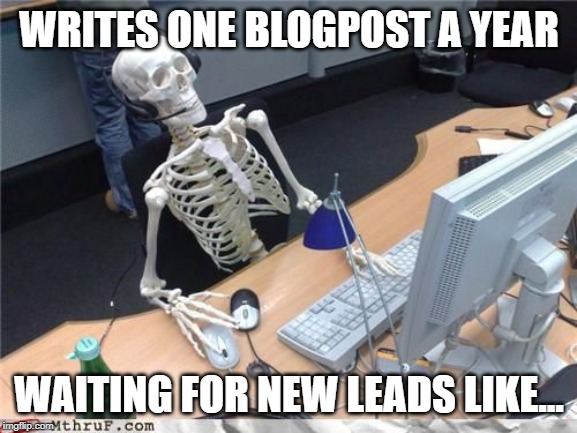Okay, so you probably already know, unless you’ve been living under a rock, that it is all about producing content these days. LOTS of content.
You can think of your content as the gasoline in your "marketing machine". It’s the foundation you have to build before your’e able to reach new customers and tell your story. But content is also needed to convert potential customers and engage your existing audience. And as you probably understand by now, it is impossible to get good results without enough content.
Good content creates trust and "educates" the customer. If you succeed with this, your content actually does two things:
- Creates goodwill on the part of the customer by offering them something of value before they have bought anything.
- Position yourself as an "expert" in solving your customers problems, and the obvious choice when they decide it’s time to buy.
The key takeaway here is that the content must create value. Or In other words, must be "useful" or at least entertaining. And...If you can do both things at the same time it’s even better!
You are not rambling on about how great you are and pushing your product/service in people’s faces. Instead, you are providing value without demanding anything in return.
Ok... So I’m done with my rant about creating value.
Right now you might be thinking - “The problem isn’t that we don’t produce content, or that we don’t value it’s importance. We even have a lot of great ideas written down somewhere... The problem is simply that things are moving too slow. Creating content takes time and resources, and we lack time and resources!”
Ok, so virtually everyone has this exact problem. But don't worry. Instead, prepare a cup of coffee, and take a look at these 10 tips:
1. Reuse, recycle, update and improve your existing content.
Before I go into this: Be careful not to duplicate your content. Simply copying old content can have a negative effect. Especially considering your google ranking. Google will find out...trust me. And besides that, duplicating things doesn’t really create any value. What I am talking about is finding new ways to use the content, or at least making enough changes so that it is not a duplicate anymore. Consider this...
- You have an old outdated blog post - Is the topic you are writing about still interesting today?
With a little information updating and customization, you can create a new, improved version of that post. Add something with "2019" or "updated for 2019" (or 2020 if that’s more correct) and you have a new, relevant post.
- Already have some video content collecting dust?
- Do you have photos that you haven't used but that you could freshen up with some photo editing?
- Have you recorded a podcast that you could reproduce as a series of blog posts?
- Did you give a presentation from a seminar that you could later publish online, or turn it into a "freebie-pdf" that people can download from your website?
It's all about for digging for gold in your old trash, and sometimes you actually find it.
2. Save time by creating content about things you already know A LOT about.
Write small guides on how the customer can use the product or how to solve problems with the product. You can skip any research phase and the content will be of good quality.
What if you are knowledgeable but not good at writing or editing? Write a draft, do the rough work and pass on the content to a colleague who is more experienced in editing.
3. Use speech recognition to quickly get your ideas down on paper.
Most smartphones and tablets are equipped with a voice assistant, whether it's "siri" for iOS, Google Assistant or other variants. Most people know this, but what many don’t realize is that this technology is starting to become so good that you can "write" an entire blog post without any major problems while sitting in the car on the way home from work.
Yes, you need to do some editing afterwards, but the fact that you get your thoughts down on paper much faster will save you a lot of time.
4. Turn your own templates and presentations into content.
Example: So let’s say you work in accounting and have created a custom visual calendar that lists all the important dates and deadlines this year. You have received good feedback from your colleagues, who find it useful and it strikes you that your customers may also benefit from this.
So you create and publish a downloadable pdf-file that you can offer website visitors in exchange for their contact info. All of a sudden you start getting a few leads every week from your calendar, without you doing anything. If the content is good and solves a common problem, you are sure to get new leads.
Not convinced yet? Here are some ideas for what you can do with just one good powerpoint presentation:
- Share the powerpoint presentation file with customers or leads.
- Need to present again? Film yourself on stage and create your own "ted talk".
- Make a video presentation: Record a video where you record your own voice and screen as you talk your way through the presentation. (P.S Remember to use a good microphone!)
- Use the content in a podcast episode.
- Turn your presentation into a blog post.
- Turn your presentation into an infographic.
- Use the presentation as content in a webinar.
- Use the presentation as content in a larger production like an e-book.
5. Use software to speed up your content marketing.
There are a number of tools that simplify the process and allow “non-professionals” to create content that looks “professional”. These are just a few examples of all the opportunities that exist out there. Many of these tools will let you design things from scratch, but they also have thousands of templates to choose from which can save you a lot of time.
promo: https://promo.comLets you compose video clips with text, image and video for a cheap price and a fraction of the time it would take in a more advanced editing program. YES, of course, it does set some artistic limitations, but in return you can test ideas quickly.
Canva: https://www.canva.com/Graphic design for non-graphic designers. When you need visual content for social media, website, blog post, newsletter and more.
Venngage: https://venngage.com/Communicate insights, data or stories with great infographics and presentations. You can even retrieve "boring" data from your own excel sheets and turn them into infographics.
Facebook business manager: www.business.facebook.com
Facebook's advertising platform is a tool many marketers already use, and it also offers tools to help you create compelling ads faster and more effective like for example video ad templates and instant articles. In fact, you can make Facebook videos without having any video footage! Facebook lets you fill images and text into animated templates, which in turn becomes neat looking video slideshows.
And by the way... if you lack sufficient video and pictures, you might want to take a look at the following tips on the list.
6. Combine your own content stock images - or video.
There are a number of websites that allow you to search for and download thousands of videos and images. These are usually cheap or even free to download and by cleverly combining them with your own content the audience won’t even notice that you are using “stock content” - And if they do, they will likely not care either way.
Stock Photos & Stock Videos:- There are similar services if you need music. Like this one: https://www.premiumbeat.com
- Google: If you are looking for free images, you can also do an advanced Google image search where you use the predefined filter “labeled for reuse”.
PS! Before you throw yourself into this, I will first make two recommendations.
- Stay away from the typical cliché images. Pictures of fake-smiling customer service reps with whitened teeth, or other "cheesy" motives looks ridiculous and can make a bad impression.
- Try to do something more creative with the stock photos than just using them as they are. For example, combine with your own text or illustrations, put on filters etc.
 Good job team! Such business. Very professional. Much dealmaking
Good job team! Such business. Very professional. Much dealmaking7. Get everyone blogging!
Naturally, not everyone in your company will be a savvy writer.. But everyone can contribute with their unique knowledge. Those who are not comfortable with writing their own posts can write down their knowledge of a specific topic, and then submit it to a colleague who is more skilled at editing.
Pick a common issue you know your ideal clients are having and then get one of your experts to set aside 20 minutes and brain-dump everything they know about that topic onto a word-document and you will have the foundation for a good blog post right there.
8. There is no shame in sharing great content that others have created. (As long as you don't try to take credit yourself.)
Example: Bob runs an online-store that sells boat engines. He recently came across some great articles that solve an important problem that he knows his customers are having and that also relates to the products he sells. Bob thinks the articles could be useful to his own customers, and therefore shares the links with them on his company's Facebook page. “I came across these articles that solve problem xyz with boat engines. This may be of interest to you dear customers.” The customer thinks Bob is a good guy, and relies on his tips when it comes to boat engines. He seems like a service minded guy who knows a lot about boat motors and he always shares useful information even if it comes from other sources. Bob is smart. Be like Bob…
9. Don't over-analyze what to create content about.
The danger of over-analyzing is that you feel like you are productive and have “come a long way” when you are in fact not.
If you know your own products and customers well, some ideas should come up fairly quickly. You should also research frequently asked questions from customers, google search phrases, competitors content ect. To get started quickly, it is best to start talking about things you already know and care about.
- Start simple by generating a handful of ideas.
- Talk about how to solve problems (Not just about yourself!)
- Get your content quickly out on the internet to test it.
- Adjust to the results. Make more of, or hone in on, the content that works.
- Continue testing new content.
10. Put content production into system.
It might not come as a surprise that you should create a system to speed up your content marketing. There are two helpful tools that I think everyone should use in this context:
- Suggestion box: A simple document where you and your team gather all your ideas. It’s also a framework that helps you prioritize the ideas.
- Content plan: A simple and concrete plan for the next 2-3 months. It should specify what to do, when to do it, and who will do what. As you may have experienced - If you haven’t set a deadline, the task will not get done.
Without planning there really isn’t enough pressure and structure in place for most businesses to create content on a regular basis. Too many businesses underestimate the effort they have to put into content marketing and over-estimate the results they are going to get from one single article. “I posted something yesterday - Where are the leads?”.

Summary
Succeeding with content marketing is no simple matter, and it requires practice like everything else. The key to success lies in being able to produce content on a consistent basis while at the same time be able to maintain a high quality. Make no mistake, quantity should not come at the expense of quality. But you will need to use your good judgement on this because it's at the same time true "that good is better than perfect". Just keep in mind that you shouldn’t create content just for the sake of producing content.
Luckily, by using these tips I can guarantee that you will speed up your content production and gain an edge over many of your competitors. In fact I dare you - create a content plan and use these tips for a month or two. Then review the results for yourself.
Content marketing requires good planning and a constant stream of new content.
Do you have questions about what we should write about? Feel free to send me your thoughts or questions to Åsmund Holtan - ah@couplerhq.com






